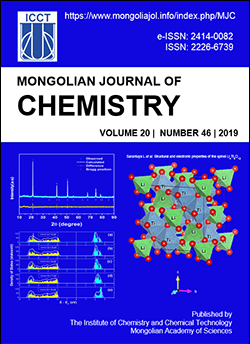Study on removal of Se(IV) using Fe-Mn layered double hydroxides and Fe-Mn Dos (double oxides)
DOI:
https://doi.org/10.5564/mjc.v20i46.1239Keywords:
Adsorption, double oxide, layered double hydroxide, seleniumAbstract
In this study, Fe-Mn-CO3 layered double hydroxide (LDHs) and Fe-Mn Double oxide (DOs) were synthesized by the co-recipitation methods for Se(IV) removal from aqueous solutions. The Se(IV) adsorption capacities and removal mechanism of Fe-Mn LDH and Fe-Mn DOs determined by batch and column experiments. The calculated Se(IV) adsorption capacities on Fe-Mn LDH and Fe-Mn DOs were 52.5 and 55.3 mg/g, respectively. Kinetic models applied to the adsorption of Se(IV)
on the Fe-Mn LDH and Fe-Mn DOs calculated using pseudo-first, second-order, Elovich, and Intraparticle diffusion kinetic models and all kinetic parameters were calculated and discussed. Isotherm studies were also performed using Langmuir,
Freundlich, Temkin, and Dubinin-Radushkevich equations in the temperature range of 283 - 323 K. Adsorption kinetics and isotherm experiments are well fitted pseudo-second order model and Freundlich isotherm, respectively. The production of this adsorbent is cost-effective for industrial applications.
Downloads
1595
References
Ruth E. Wolf, T.M.H., Philip L. Hageman, Suzette A. Morman, and G.S.P., (2010) Speciation of Arsenic, Selenium, and Chromium in Wildfire Impacted Soils and Ashes, 1-29, https://pubs.usgs.gov/of/2010/1242/pdf/OF10-1242.pdf.
Tan, L.C., Nancharaiah, Y. V., van Hullebusch, E.D., Lens, P.N.L., (2016) Selenium: environmental significance, pollution, and biological treatment technologies. Biotechnol. Adv., 34, 886-907, https://doi.org/10.1016/j.biotechadv.2016.05.005
Goh, K.H., Lim, T.T., (2004) Geochemistry of inorganic arsenic and selenium in a tropical soil: Effect of reaction time, pH, and competitive anions on arsenic and selenium adsorption. Chemosphere, 55, 849-859, https://doi.org/10.1016/j.chemosphere.2003.11.041
WHO, (2017) Guidelines for drinking-water quality, 4th edition, incorporating the 1st addendum, http://www.who.int/water_sanitation_health/publications/drinking-water-quality-guidelines-4-including-1st-addendum/en/.
Dadwhal, M., (2010) Adsorption of Trace Levels of Arsenic and Selenium from Aqueous Solutions by Conditioned Layered Double Hydroxides. University of Southern California Dissertations and Theses. University of Southern California, (2010).
Bleiman, N., Mishael, Y.G., (2010) Selenium removal from drinking water by adsorption to chitosan-clay composites and oxides: Batch and columns tests. J. Hazard. Mater., 183, 590-595, https://doi.org/10.1016/j.jhazmat.2010.07.065
Dessì, P., Jain, R., Singh, S., Seder-Colomina, M., et al., (2016) Effect of temperature on selenium removal from wastewater by UASB reactors. Water Res., 94, 146-154, https://doi.org/10.1016/j.watres.2016.02.007
Sharrad, M.O.M., Liu, H., Fan, M., (2012) Sep. Purif. Technol., vol. 84, 29-34, pp. 29-34. https://doi.org/10.1016/j.seppur.2011.07.011
Das, J., Sairam Patra, B., Baliarsingh, N., Parida, K.M., (2007) Calcined Mg-Fe-CO3 LDH as an adsorbent for the removal of selenite. J. Colloid Interface Sci., 316, 216-223, https://doi.org/10.1016/j.jcis.2007.07.082
Tian, N., Zhou, Z., Tian, X., Yang, C., Li, Y., (2017) Superior capability of MgAl2O4 for selenite removal from contaminated groundwater during its reconstruction of layered double hydroxides. Sep. Purif. Technol., 176, 66-72, https://doi.org/10.1016/j.seppur.2016.11.062
MSE Applicaitons Technology Inc. (2001) Selenium Treatment/Removal Alternatives Demonstration .
Sideris, P.J., Nielsen, U.G., Gan, Z., Grey, C.P., (2008) Mg/Al ordering in layered double hydroxides revealed by multinuclear NMR spectroscopy. Science (80-. )., 321, 113-117, https://doi.org/10.1126/science.1157581
Song, F., Hu, X., (2014) Exfoliation of layered double hydroxides for enhanced oxygen evolution catalysis. Nat. Commun., 5, https://doi.org/10.1038/ncomms5477.
Sajid, M., Basheer, C., (2016) Layered double hydroxides: Emerging sorbent materials for analytical extractions. TrAC - Trends Anal. Chem., 75, 174-182, https://doi.org/10.1016/j.trac.2015.06.010
Sujata Mandal S., Mayadevi and Bhaskar D., Kulkarni (2009) Adsorption of aqueous selenite [Se(IV)] species on synthetic layered double hydroxide materials. Ind. Eng. Chem. Res., 48,7893-7898. https://doi.org/10.1021/ie900136s
Zhang, G.S., Qu, J.H., Liu, H.J., Liu, R.P., Li, G.T., (2007) Removal mechanism of As(III) by a novel Fe-Mn binary oxide adsorbent: Oxidation and sorption. Environ. Sci. Technol., 41, 4613-4619, https://doi.org/10.1021/es063010u
Basu, D., Das, A., Wang, D.-Y., George, J.J., et al., (2016) Fire-safe and environmentally friendly nanocomposites based on layered double hydroxides and ethylene propylene diene elastomer. RSC Adv., 6, 26425-26436, https://doi.org/10.1039/C5RA27444C
Gupta, A., Balomajumder, C., (2015) Biosorptive performance of Escherichia coli supported on Waste tea biomass (WTB) for removal of Cr(VI) to avoid the contamination of ground water: A comparative study between biosorption and SBB system. Groundw. Sustain. Dev., 1, 12-22, https://doi.org/10.1016/j.gsd.2016.01.001
Zhang, N., Lin, L.S., Gang, D., (2008) Adsorptive selenite removal from water using iron-coated GAC adsorbents. Water Res., 42, 3809-3816, https://doi.org/10.1016/j.watres.2008.07.025
Downloads
Published
How to Cite
Issue
Section
License
Copyright on any research article in the Mongolian Journal of Chemistry is retained by the author(s).
The authors grant the Mongolian Journal of Chemistry a license to publish the article and identify itself as the original publisher.

Articles in the Mongolian Journal of Chemistry are Open Access articles published under a Creative Commons Attribution 4.0 International License CC BY.
This license permits use, distribution and reproduction in any medium, provided the original work is properly cited.








